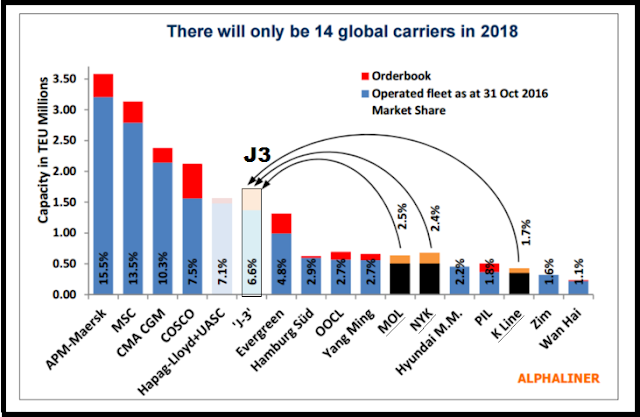Japan’s big three shipping majors – NYK, K Line, have decided to end decades of fierce rivalry and merge their container shipping businesses into a new line ( a new joint-venture
company ) with a total capacity of 1.4m TEUs , which would rank as the sixth
largest in the world and have a global market share of approximately 7%.
When will J3 be
operational?
The deal was subject to shareholders’ agreement and
regulatory approval with a planned establishment of the new company scheduled
for 1 July 2017, and the target for
business commencement set for 1 April 2018.
What is in it for the
shipping trade?
·
“J-3” will become the world’s sixth-largest
container line, with the top seven lines controlling around 65 percent of the
global liner capacity by 2018.
·
The J3 will operate a combined fleet of some 1.4million
twenty-foot-equivalent units with a global market share of about 6.6 percent, based
·
J3’s JOINT order book totals 358,000 TEUs
Before J3 & After
J3
According to vesselsvalue.com, NYK owns the largest
container fleet, with 68 vessels providing a total capacity 507,046 teu, valued
at $2.33bn; followed MOL, with 35 ships for 307,449 teu, valued at $1.7bn, and
third K Line, which owns 31 containerships with a capacity of 240,440 teu and a
value of $1.2bn.
It has been agreed that the shareholding of the container
line joint venture will be: K Line 31%, MOL 31% and NYK 38%, with a total
contribution of Y300bn, including fleets and share of terminals, but will
exclude terminal operating business in Japan.
:
Why go for J3?
We will look at the reasons for J3 :
We will look at the reasons for J3 :
1. Stability : The
three Japanese companies have made efforts to cut cost and restructure their
business, but there are limits to what can be accomplished individually. Under
such circumstances, the 3 carriers have decided to integrate their container shipping
business so that they can continue to deliver stably high quality and customer
focused products to the market place.
In the past few years container liner shipping has been a
problem child for all three of the Japanese trio as they have found themselves
increasingly unable to match the economy of scale unit benefits enjoyed by the
big three of Maersk Line, MSC and CMA CGM.
2. J3 is part of THE Alliance:
A factor in the decision to merge their container activities is that the
Japanese carriers will all be members of the new THE Alliance east-west vessel
sharing grouping from April next year, which makes the integration
significantly less complex.
After the bankruptcy of Hanjin Shipping and the merging of
the Japanese trio - THE Alliance will be streamlined into three carriers: Hapag-Lloyd,
Yang Ming and the new Japan carrier J3 , thus overcoming the “too many cooks”
criticism that has previously been levelled by analysts at the grouping.
3. Japanese shipping majors share a Common corporate
culture : Moreover, the Japanese shipping groups have a close relationship
that stems from their “common corporate culture” with senior executives and
operational management naturally familiar with their counterparts at the other
companies.
4. Competition’s M&A activity: The container shipping industry
witnessed a flurry of M&A activity in the past year – with of CMA CGM’s
acquisition of NOL, Hapag-Lloyd’s merger with UASC, and the merging of the two
Chinese state-owned lines – has widened the gap in this sector and proved a
drag on consolidated group results for the Japanese companies.
According to Alphaliner data the merger of Hapag-Lloyd and
UASC will lift the German carrier to fifth in the world rankings at 1,479,968
teu capacity, behind the merged Cosco and CSCL at 1,560,999 teu, with the
proposed Japanese grouping taking the sixth spot with 1,369,728 teu.
 |
| Top Lines - in 2018? |
Other facts: The three companies all operate portfolios of diversified enterprises that include: bulk shipping, car transportation, LNG, tankers, offshore, energy heavy lift and air cargo transportation.The three japanese majors have significant overlapping interests in terminals worldwide which may need to be rationalized.

No comments:
Post a Comment
Note: only a member of this blog may post a comment.